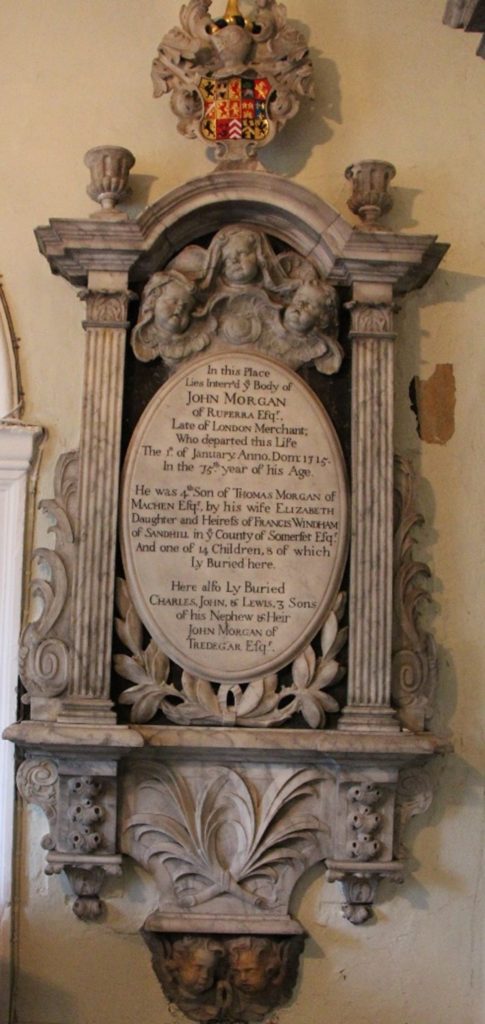The Morgan Chapel and its Monuments and Ledgers
In 1710 John Morgan “The London Merchant” retired after spending 40 years in the City of London and acquired the Lordship of Wentloog and with it, the patronage of the Church in Machen. It would seem that one of his first tasks on his return was to commission the building of this elegant chapel, which has become a mausoleum for generations of the Morgan family. Here, he and his family living at Rhiwperra Castle could worship privately at Sunday services in relative comfort separated from the rest of the congregation. The “Remarkable” Morgan Chapel.

The Morgans set the time of services at 11.15 a.m. which enabled their servants to finish their household chores and walk to church, (1.5 miles through the fields, or over 3 miles by road), to greet the Morgan family arriving by carriage. The tradition has been kept and the time of the service remains at 11.15 to this day.
Measuring just under 15 feet square, the chapel is built from rubble stone and abuts the 13thcentury chancel. The east wall is set with a 19thcentury Gothic window and is gabled to match the chancel.

Inside the Church, elaborately decorated black and gold scroll leaf wrought iron gates set in an early 18th century classically moulded entrance arch give access to the chapel from the chancel. The gates are believed to have been made at the forge in Bassaleg.

The delicate deep coved plaster ceiling stands on a classical cornice. Set within the stone flag floor are 8 Morgan Family tombs dating from the 18th century, where 14 adult members of the family and 11 infants have been buried.
The fireplace on the west wall with its reeded surround is now infilled and inscribed “Virtus Vincit” (Power will prevail). The original fireplace was thought to have become redundant in 1901. During major repairs and alterations, it had been decided to adopt the “hot air” principle of heating the church, financed by public subscription. The rather ugly radiators and pipework of this early central heating system were removed in 2020 during the conservation project to restore the chapel to broadly its appearance at the end of Queen Victoria’s reign. However, the discovery in 2020 of an opening for a stove-pipe chimney in the ceiling above the altar indicates an alternative form of heating was installed much earlier. A coal or log burning stove may have been installed c.1838 when the Revd Augustus made changes to the chapel to use it as his vestry.
The Chapel displays a number of monument and ledgers, you can find out more information and the history of the Morgans associated with them by clicking on names below . If you want to know more about the history of the Morgan Chapel and the Morgan Family, then head to the “Remarkable” Books page where you can purchase our books!

John Morgan “The London Merchant” Monument 
John Morgan and Sir William Morgan Double Monument 
Charles and John Morgan Double Monument 
Revd Augustus and Mrs Frances Morgan Monument 
Charlotte Ann Morgan Monument 
Honourable Frederic Courtenay Morgan Monument 
‘Colonel’ Thomas Morgan Ledger 
‘General’ Thomas and Jane Morgan Ledger 
Katharina Morgan Ledger